The south-east city of Portsmouth has seen its fair share of history. With a famous residents roll call that includes Henry VIII, Horatio Lord Nelson and literary heroes such as Dickens and Arthur Conan Doyle, it’s little wonder that history oozes out of Portsmouth’s every pore.
By Tina Ediss
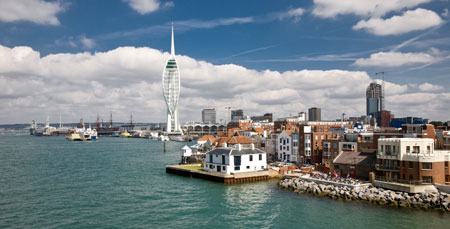
In 1194 King Richard the Lionheart had been on his way from Portsmouth to fight in some far away crusade. However, the winds and tides were against him and he ended up staying for two weeks.
This was quite a long time in Richard the Lionheart terms as he spent just six months of his ten-year reign in England.
This unplanned visit would prove to be important to Portsmouth as the King granted the townspeople a Royal Charter giving them certain rights.
Portsmouth was founded in 1180 by Jean de Gisor, a wealthy Norman merchant, who created a port at the wiggle of a waterway now known as Camber Quay. The town’s position was perfect for trading with France – or attacking it during the period of prolonged warfare in the 14th century.
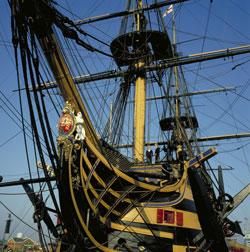 |
| HMS Victory at Portsmouth Historic Dockyard |
Then largely undefended, Portsmouth was attacked by the French and destroyed by fire on a regular basis. Eventually fortifications were built and added to by Henry VII who also created the world’s first naval dry-dock here in 1495. As the Navy grew, so did Portsmouth and the city has a
rich and important naval heritage.
The city sits on the Solent, a busy body of water between the Isle of Wight and mainland southern England. The waterway is a vital shipping route as well as a popular playground for recreational craft.
Portsmouth is actually a large island, separated to the north by a narrow creek. It’s a sprawling city yet the main areas are fairly compact. Old Portsmouth is home to the Cathedral Church of St Thomas of Canterbury and some of the older buildings that survived the bombs of the Second World War. It leads neatly to the Point, an area of cobbled streets and salty pubs where press gangs were feared and sailors parted from their hard earned
money. It is also called Spice Island, which could be because of the spices imported here – or because of its once spicy reputation.
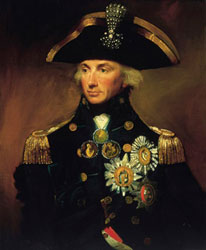 |
| Naval hero: Admiral Horatio Nelson |
The Hard is where Portsmouth Historic Dockyard is situated. It is the city’s most popular attraction with three impressive ships, HMS Victory, HMS Warrior and Henry VIII’s Mary Rose.
The best loved is HMS Victory dating from 1759. The oldest commissioned warship in the world, she carried Admiral Horatio Nelson to victory in the Battle of Trafalgar.
He was fatally wounded during the battle and died three hours later, knowing the battle was won.
Nelson became a hero and his aptly named ship a national treasure. She’s not sleek like the ships of today. Her belly seems rotund, as if it’s bulging with all she needed to carry. The ship can be explored from the depths of the hull to the Great Cabin where Nelson planned the battle. She’s rich with an assortment of evocative nautical aromas. Smells of wood, of rope, of tar, of provisions once carried, of decks well scrubbed and brass brightly polished.
HMS Warrior was launched on 29 December 1860 and was the world’s first iron-clad battleship. She never fired a shot in anger but deterred with some efficiency; wooden warships didn’t dare challenge her.
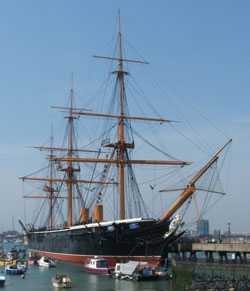 |
| HMS Warrior, the first iron-clad warship |
Stationed onboard are costumed volunteer tour guides like Bill White, an ex-naval man. “There’s not another ship in the world like her,” he says proudly. “This is an unique job. We get visitors from every nation, all different and all happy because they are on holiday. In fact, my job means that I can say welcome in 11 languages.”
The third of the ships, the Mary Rose, is really just half a hulk but her story is incredible. She set sail on a summer’s day in 1545 with Henry VIII watching proudly from the shore. Then, for no reason that’s ever been discovered, she sank, taking 400 souls with her. For 437 years the Mary Rose lay on the seabed, protected by the silt of the Solent.
In October 1982, she was dramatically raised from the deep and displayed in the Mary Rose Ship Hall. She has now disappeared from view as a new museum, due to open in 2012, is built around her.
Many of the fascinating artefacts found with her are on display in the Mary Rose Museum. These objects give remarkable insights into Tudor times. There are many weapons; cannons and cannonballs, long-bows and arrows but it’s the personal items that turn these ancient mariners into people; bowls, spoons, shoes, leather jerkins, carpenter’s tools, rulers, combs even a backgammon set.
There’s so much to see in the Dockyard; Actions Stations is a favourite with children who can have a try at being in the Marines. There’s also the Royal Navy Museum and a boat trip around the harbour.
The city played a vital role during the Second World War. The naval presence and the docks made Portsmouth an obvious target for ruthless Luftwaffe bombers. Much of the city was reduced to ruins, centuries old buildings lost forever. On D-Day the city was an embarkation point for men heading for the Normandy Beaches; the story is told in the D-Day Museum. A little farther along on Southsea Common stands the Portsmouth Naval Memorial commemorating sailors who died at sea during the First and Second World Wars.
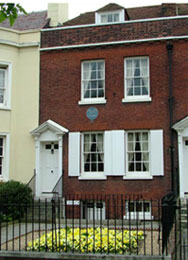 |
| Charles Dickens’ birthplace |
Portsmouth has some impressive literary links. Charles Dickens was born in the city on 7 February 1812; his terraced house is now the Charles Dickens’ Birthplace Museum. Arthur Conan Doyle worked in the city as a doctor while writing his Sherlock Holmes novels. There’s a fascinating Arthur Conan Doyle Collection at the City Museum. I have a special interest in Victorian writer Sir Walter Besant, born in Portsmouth in 1836. His mother was Sarah Ediss and we are distantly related. In his autobiography he talks about growing up in Portsmouth and how the city walls were “the playground, the breathing place for the children and the
boulevard for the people.”
And so they remain: people promenade the walls along the seafront on all but the stormiest of days. Children play as they’ve always done, not particularly impressed, orunaware of the age of the Round Tower (1418), the Square Tower (1494) and Southsea Castle (1544).
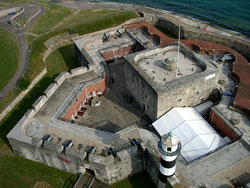 |
| Henry VIII’s Southsea Castle on the seafront |
Southsea’s little shops along Marmion Road and Albert Road are good for shopping. They are a bit edgy, a bit New Age with everything from hand-made chocolates and delicious cakes (try Snookies on Osborne Road) to fashion and antiques. There is also a good shopping in the city centre, however most shoppers head for the bargains to be had at the outlet stores of Gunwharf Quays. Dine alfresco here at one of the restaurants facing the Solent.
It feels very continental, only often with a bit more bluster.
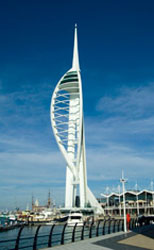 |
| Scale Spinnaker Tower |
Looking down on this historic maritime scene is the modern Spinnaker Tower that stands on the water’s edge, a giant mast with huge sails billowing. From this great height (110 metres) the view of the whole city, the countryside that surrounds it and across to the Isle of Wight, is ever changing. On a sunny day the Solent is all sparkly and blue. When the sky is overcast rays of sun pierce through the clouds and hit the sea like spotlights on a stage.
This is Portsmouth past, present and future; pick out the ordered military buildings, the fine buildings that survived the bombs of the Second World War – and the post-war buildings that could never replace all those that didn’t.
Read our listing of the top places to visit in Portsmouth
For further information on where to stay and what to do in Portsmouth www.visitportsmouth.co.uk.
Tourist Information Centre, The Hard, Portsmouth PO1 3QJ; tel: (023) 9282 6722.






 © 2024
© 2024